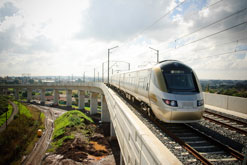
Go Gautrain Go!
Gautrain rolls out this week!!! by Lucille Davie Ministers and ambassadors were among the first people to travel on the rapid rail Gautrain, which will be running from OR Tambo International airport in time for the 2010 Fifa World Cup. (View the pics.) Gold ribbons were cut at four new Gautrain stations on 5 June […]

Gautrain rolls out this week!!!
by Lucille Davie
Ministers and ambassadors were among the first people to travel on the rapid rail Gautrain, which will be running from OR Tambo International airport in time for the 2010 Fifa World Cup. (View the pics.)
![[Image]](http://mediaclubsouthafrica.com/images/stories/june2010/gautrain-text.jpg)
Dignitaries cut ribbons at Sandton, Marlboro, Rhodesfield and the airport, signifying the route that will open on Tuesday, 8 June, just three days before the World Cup kicks off.
Guests, including cabinet ministers and ambassadors, travelled in the Gautrain, stopping at each station, and reaching speeds of 150kph on their way to the airport.
Four musicians dressed as angels in flowing white chiffon and sequined wings and suspended on swings 4m above the ground, greeted around 800 black-tie guests to the Gallagher Convention Centre, located in Midrand between Pretoria and Johannesburg, on the weekend. They were there for the serious business of witnessing the launch of the Gauteain’s airport route.
Travelling at speeds of up to 160kph, the train will carry commuters between the business district of Sandton and the airport in just 15 minutes; from Rhodesfield to Sandton in 12 minutes; and from Marlboro to Sandton in around four minutes.
Passengers travelling to the airport from any station will pay R100 ($13) for a single trip. A single trip from Sandton to Marlboro will cost R16.50 ($2.1); while trips between Sandton and Rhodesfield will cost R21 ($3). A trip from Marlboro to Rhodesfield, the station just before the airport, will cost R18.50 ($2.3).
Some 44 feeder buses are also due to run from the suburbs of Fourways, Rivonia, Blairgowrie and Wendywood, to the Sandton station. Bus stops will be positioned every 500m, and operate within a 15km radius of the stations. The bus route details are available from the Gautrain website.
Commuters who combine a bus trip or parking with a train journey will benefit from reduced rates on the bus and parking fees. Tose who use the service regularly can purchase weekly and monthly packages.
Parking garages are available for those who wish to leave their vehicles at the station precincts. There will be a “kiss and ride” drop-off facility too.
Wheelchair access is available on all trains, while blind and partially sighted and deaf passengers will be accommodated with special features adapted to their disabilities.
“The doubting Thomases have been silenced,” said Minister of Justice Jeff Radebe at the function. He praised the system for two major reasons – it was to be an integrated system, with a smooth flow between Gautrain and the national rail system; and there would be a single ticketing system.
Smart card
The Gautrain Gold smart card will allow commuters to transfer seamlessly between the train, and the bus and parking services.
The Gautrain’s operating hours are from Mondays to Fridays, from 5.30am to 8.30pm. It will run every 12 minutes during peak hours – 5.30am to 8.30pm and 4pm to 7pm – and every 20 minutes in off-peak times. On weekends the service will be available every 30 minutes.
Job creation
Gauteng Premier Nomvula Mokonyane was keen to stress that the Gautrain had contributed to economic development in the province, leading to “decent work and improved living standards”.
“As can be seen through the construction of Gautrain, Gauteng continues to utilise and promote labour-intensive methods in all our public infrastructure development projects to maximise job creation,” she said.
The Gautrain has created an estimated 94 900 direct and indirect jobs, of which more than 25 100 are local jobs. More than R3.8-billion ($486-million) has been spent on procurement from and sub-contracting to BEE companies. A further R1.8-billion ($230-million) has been spent on sub-contracting to new BEE companies, while R1-billion ($128-million) was spent on sub-contracting to SMMEs. More than R2.7-billion ($345-million) was spent on procurement of South African materials, plant and equipment.
“These numbers imply that Gautrain has significantly exceeded its socio-economic obligations,” said Gautrain spokesperson, Barbara Jensen, in a press statement.
Already property values around the stations have started to rise. It is expected that people and businesses will relocate to the precincts around the stations to fully utilise the benefits of the train.
Jensen also referred to traffic volumes between Johannesburg and Pretoria, which grow at a rate of 7% a year. She said that traffic congestion is eased, while the environmental will gain from a reduction in harmful carbon emissions.
“Gautrain is long overdue,” said Radebe.
Construction
Construction of the Gautrain began in September 2006, with a public private partnership between the Gauteng provincial government and the Bombela Concession Company.
Radebe explained that the national government had supplied R23-billion ($2.9-billion) of the cost of building the high speed rail link, while the provincial government and the private sector had contributed the remaining R3-billion ($383-million).
Both Radebe and Mokonyane praised project manager Jack van der Merwe, with Radebe saying that it seemed that Van der Merwe treated the project as if “his own life depended on [its] success”.
“Once South Africans put their minds to it, it is achievable,” added Radebe.
Construction continues on the remainder of the 80km route, with the remaining six stations at Park Station, Rosebank and Midrand in Johannesburg, and Centurion, Pretoria and Hatfield in Tshwane expected to be completed by mid-2011.